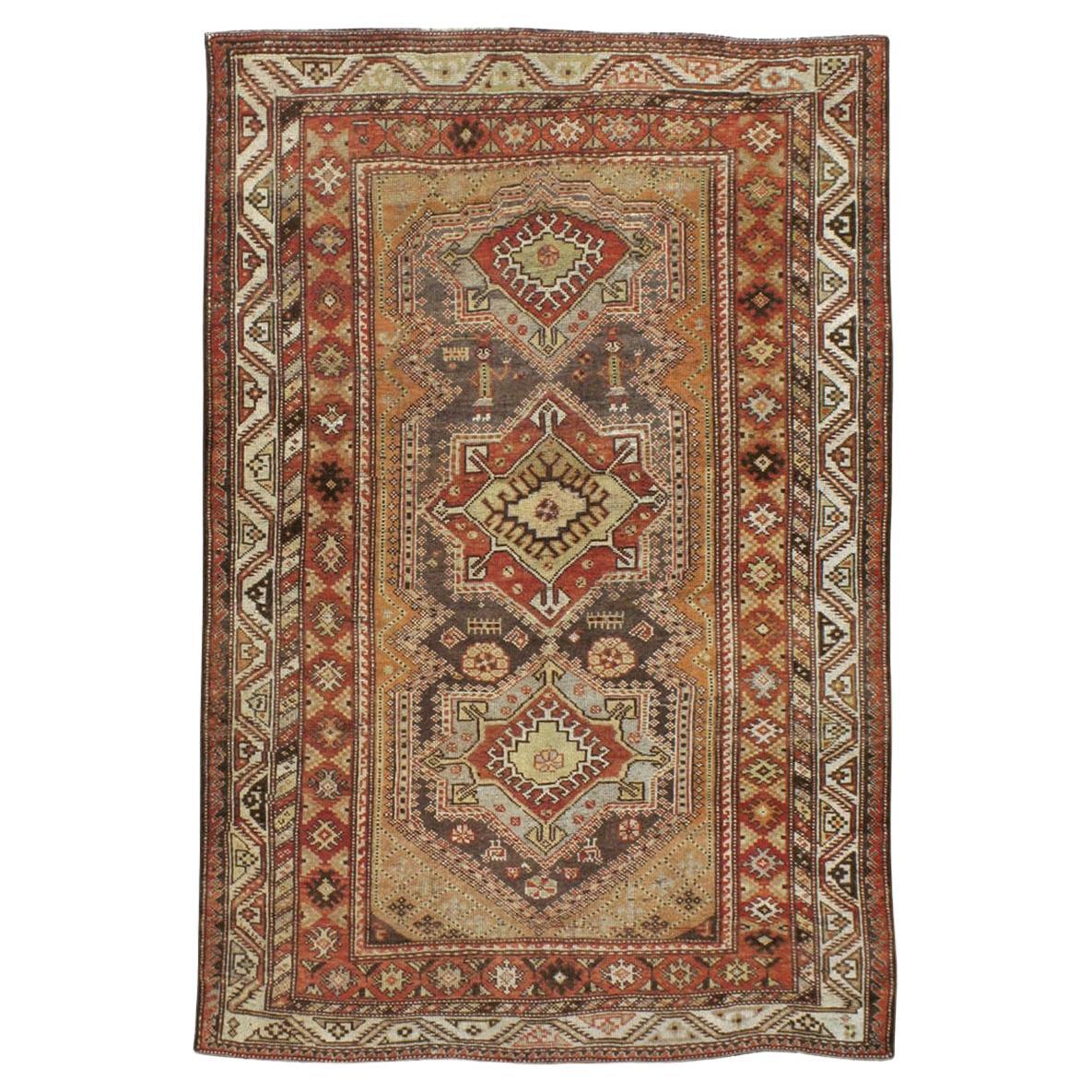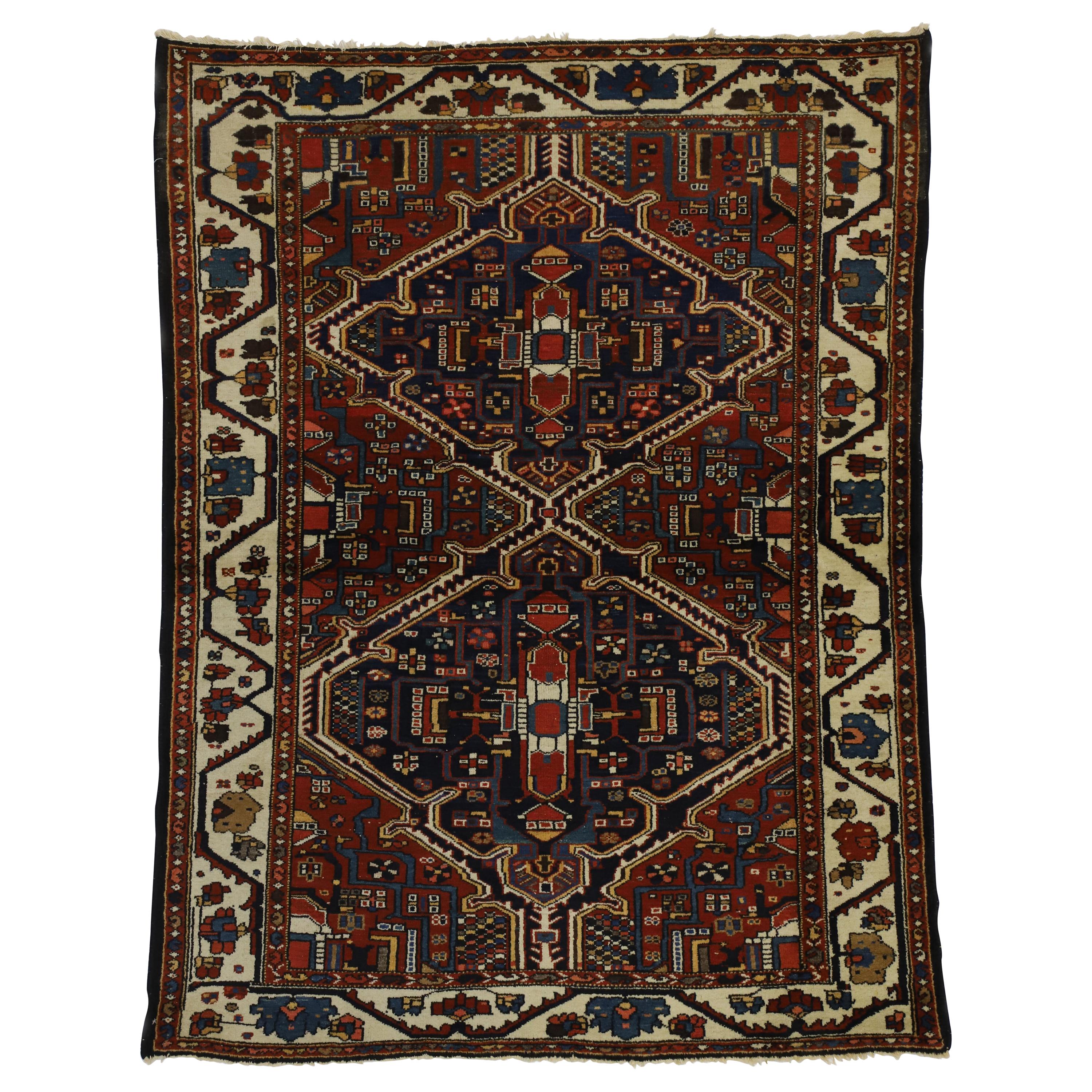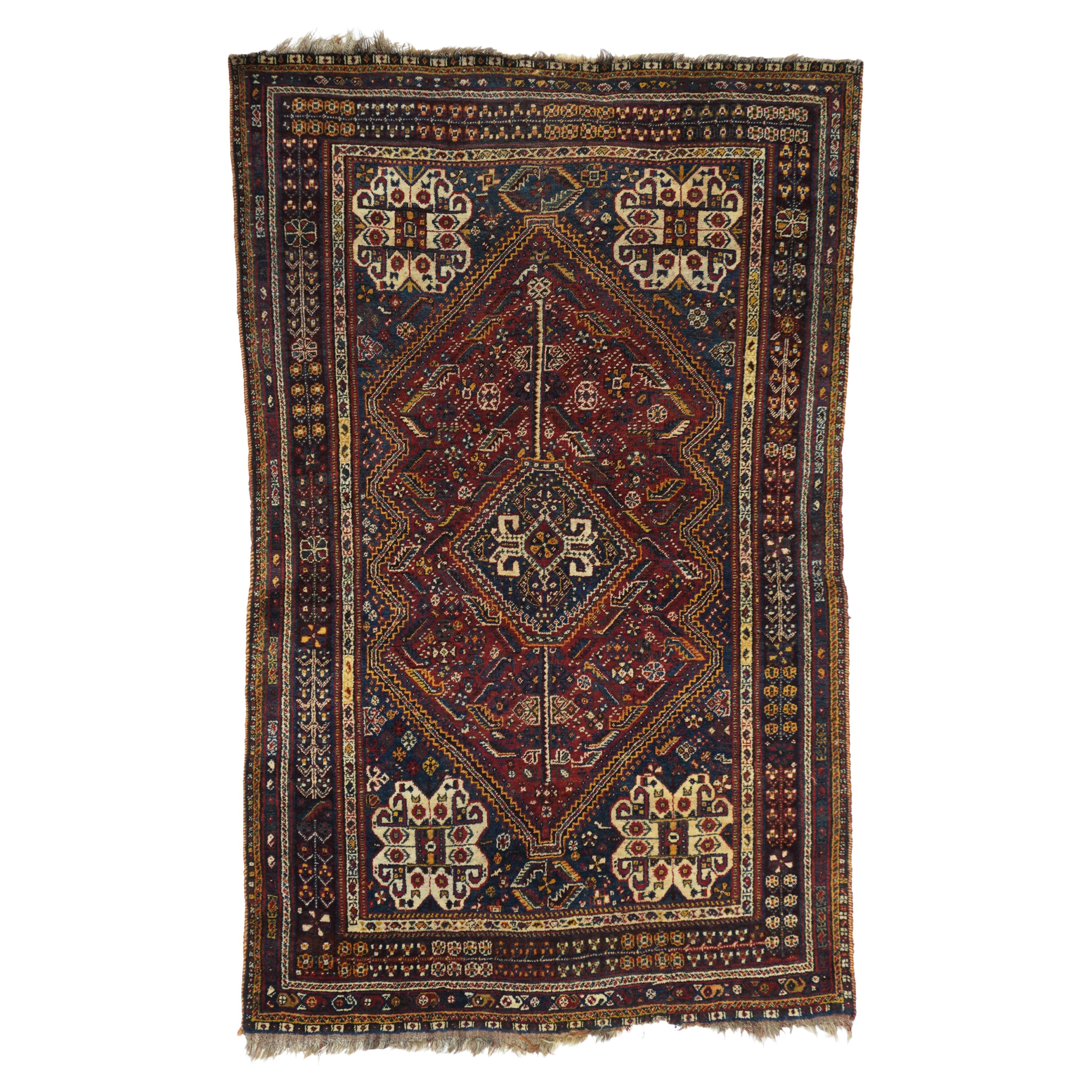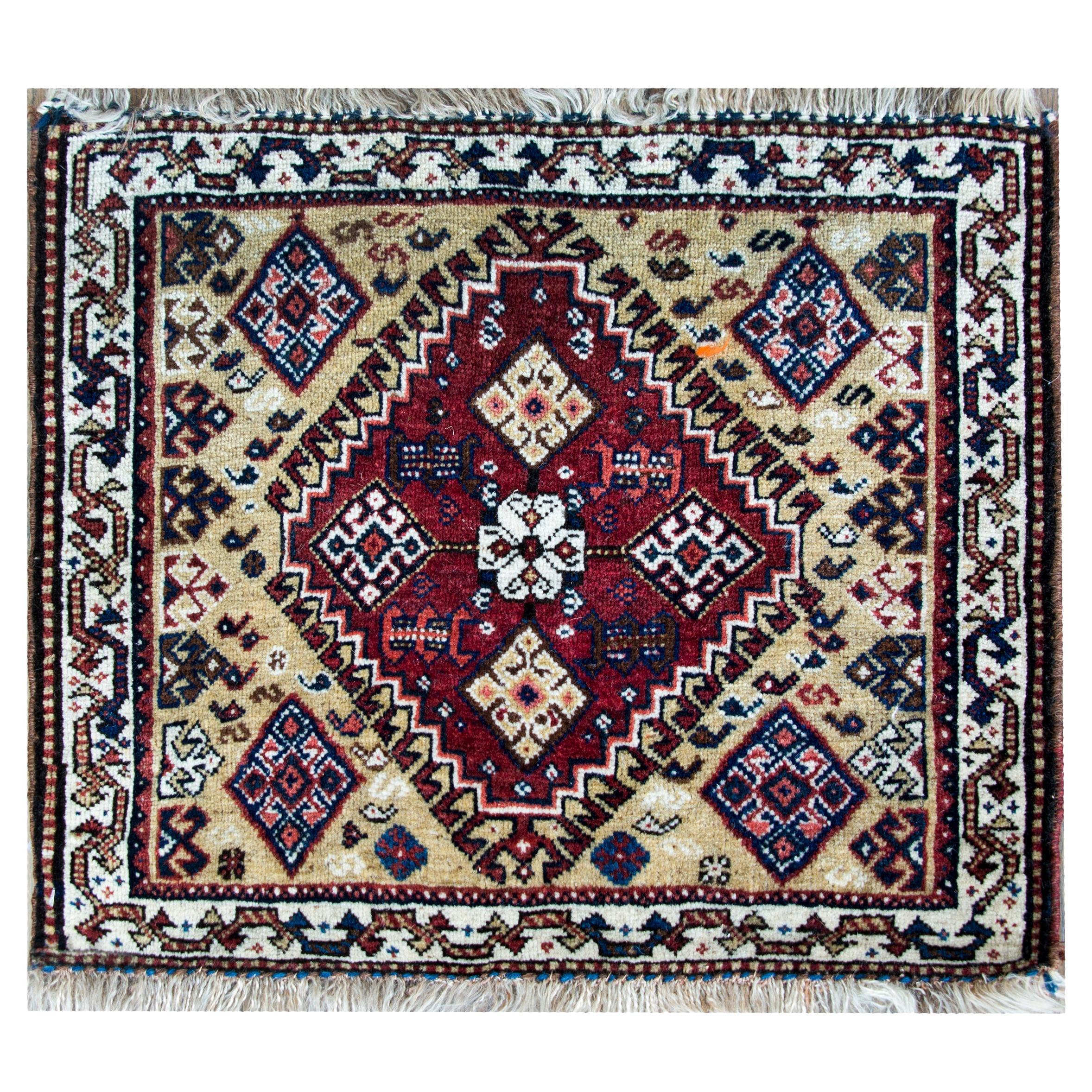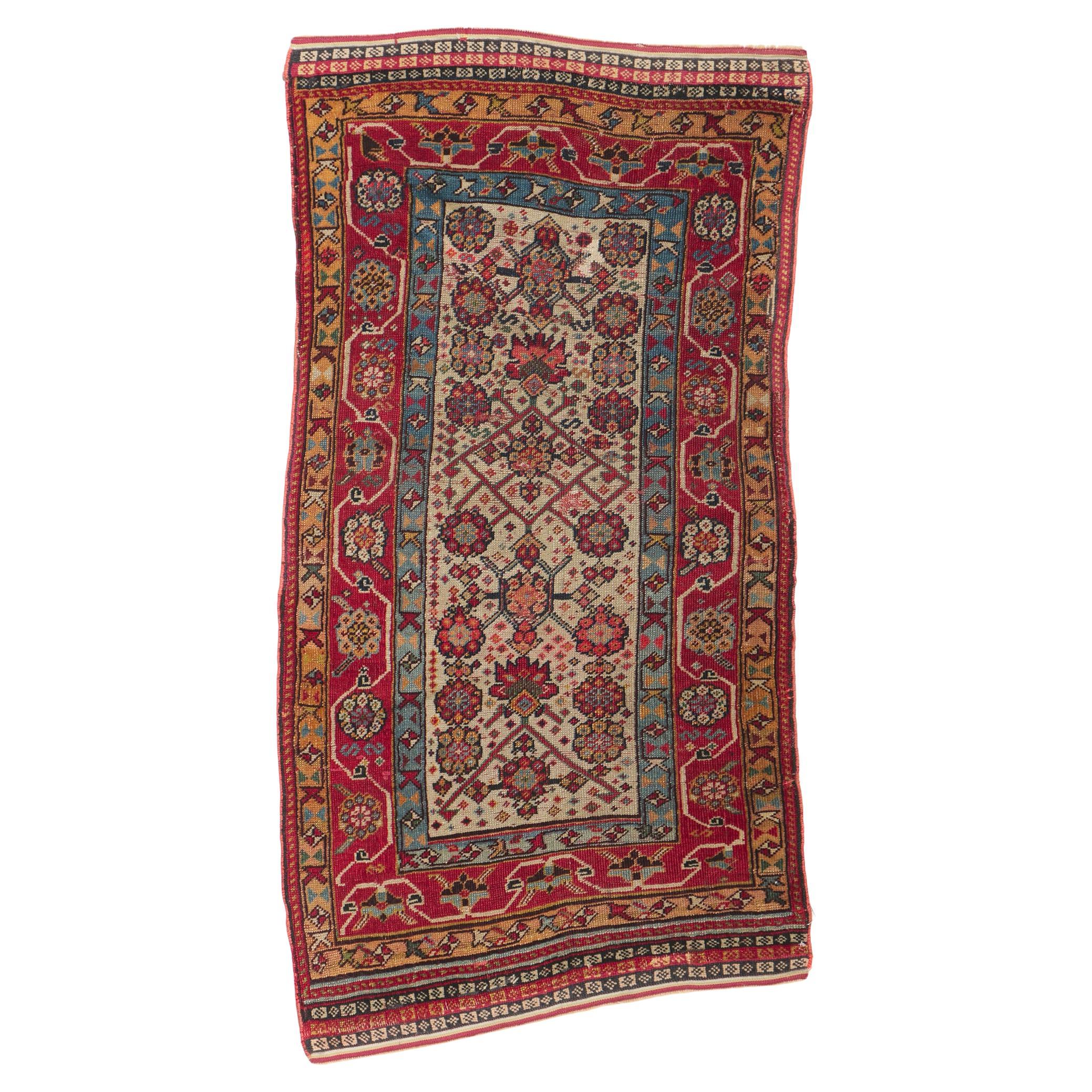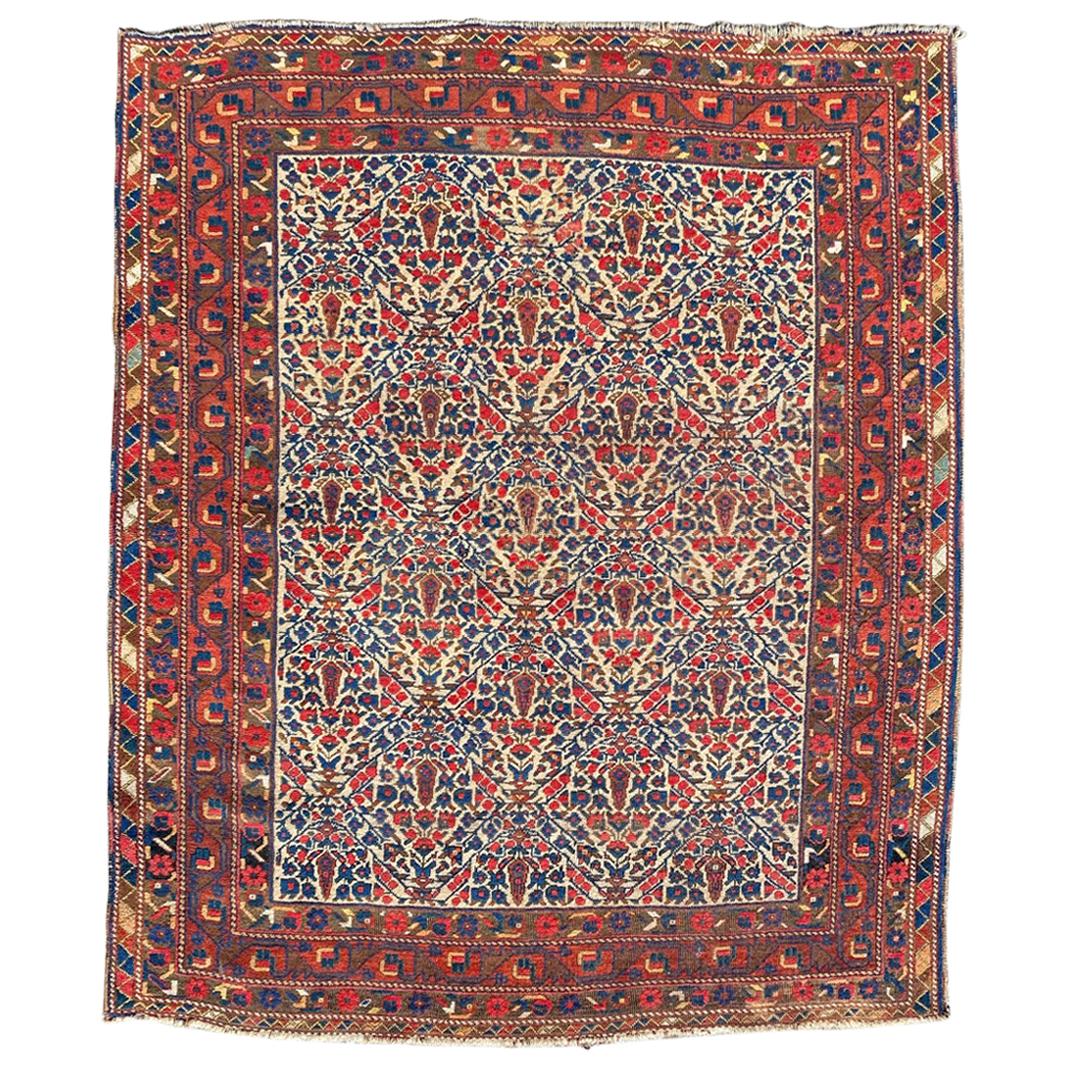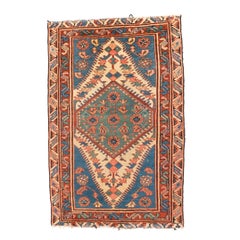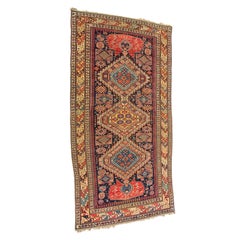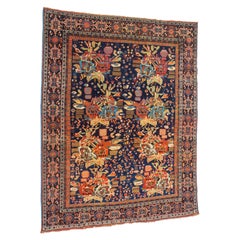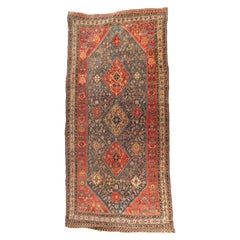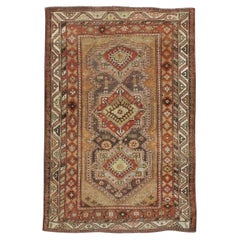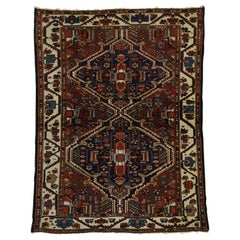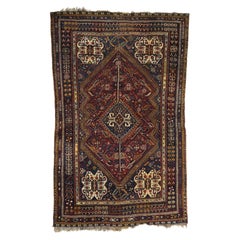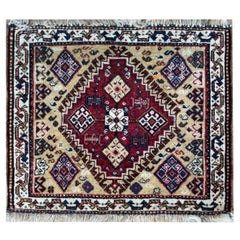Items Similar to Unusually Fine Qashgai'i 1870 Antique Tribal rug short term reduction
Want more images or videos?
Request additional images or videos from the seller
1 of 10
Unusually Fine Qashgai'i 1870 Antique Tribal rug short term reduction
$2,900
£2,197.38
€2,516.92
CA$4,107.52
A$4,482.26
CHF 2,351.02
MX$54,438.55
NOK 29,365.55
SEK 27,751.91
DKK 18,785.35
About the Item
Qashgai circa 1870-80
Qashgai, UNUSUALLY FINE ANTIQUE TRIBAL PIECE circa 1870 - 1880
3 x 5 ft
Acquired from a French dealer
The Qashgai Federation of tribes, along with the Afshar, Lori and Khamseh, have a timeless tradition of rug weaving. As nomads their work is alive with plant and animal symbols and total use of natural dyes. Sadly their nomadic ways and weaving traditions have been severely diminished by the modern world. Such pieces are a treasure from a bygone era.
This is a subtle and quietly distinguished example which requires a few moments of careful examination. The colors are deliberately subdued by the female artist/ weaver who speaks to us through symbols. Note the 4 borders and their intricate design- and at top and bottom, two additional intricate outer border strips- a sign of a dedicated weaver with a sense of composition and completeness.
There is a fine artistic interplay between the reds, beiges and unusual pale peach colors used, accented by royal and very pale blues and greens. There are actually three distinct blue hues within this rug . The delightful playfulness of symbols and design elements is a hallmark of a higher quality Qashgai'i recalling that it was made on a ground loom by a female nomad , over a period of a year or more .It is an individual and fanciful statement. Look at her treatment of these devices in the inner field .
Above all, as an indication of quality and investment value in this 150-year-old tribal artefact, is the spontaneity of the drawing in the main reserve. Note the whimsical use of different images on either side, individual arrangements of design elements – they flow, tumble, drift, are delightfully random – this is a virtue in older tribal carpets, as later pieces exhibit, often, an undesirable stiffness and order which eliminate them as serious investment collectibles.
To judge by its fine execution, it was very likely made for home use or a gift among relatives, or within the tribe, also given its size.
This piece is in excellent condition, tightly woven, and suitable for a medium wear environment, though preferably light wear, such as a TV room or den, or on a wall as it is indisputably of investment grade.
This is a fine piece with which to begin a collection with a minor investment , in a rug which will steadily appreciate particularly from the reduced cost offered here, short term , as apart of our launch on 1st Dibs , through Christmas . Shipping is capped world wide at $150.
As valuations judge not only age ( and to some extent size ) but in particular the quality of the overall composition, detail and fineness of weaving, drawing ( that is design) and very important, coloration and its use -- the rug as tribal ART- this piece can be seen as an investment .
The fair market value for a piece this fine at "low retail value" is between $4.7-5,700 . We encourage comparative review , with the a close eye to the above noted factors .
You may wish to begin a collection of tribal, or more specifically Qashgai'i rugs- you will never regret it !
Art as investment ?
The Wall Street Journal made this observation not long ago :
"The vigor of the art market may seem counterintuitive, but it makes sense in the current environment,” economist Tyler Cowen recently wrote in The Washington Post. “First, many of the wealthy have been buying additional homes and wish to furnish them with art. Second, the recent run-up in inflation rates around the world has intensified the search for hedges.”
While the aforementioned artworks fall into traditional categories, some less-prominent forms of fine art also represent ideal investment opportunities, especially because they offer more attractive—i.e., significantly less costly—entry points for new collectors. Take high-collectible and connoisseur-caliber antique Oriental rugs, for example. The best 19th-century examples often sell privately between five figures and low six figures."
- Dimensions:Width: 36 in (91.44 cm)Length: 60 in (152.4 cm)
- Materials and Techniques:Wool,Woven
- Place of Origin:
- Period:
- Date of Manufacture:1870
- Condition:Wear consistent with age and use. minor wear in one area, overall excellent condition .
- Seller Location:WYNNUM, AU
- Reference Number:Seller: 4131-1311stDibs: LU7409231394582
About the Seller
No Reviews Yet
Vetted Professional Seller
Every seller passes strict standards for authenticity and reliability
1stDibs seller since 2022
- ShippingRetrieving quote...Shipping from: WYNNUM, Australia
- Return Policy
Authenticity Guarantee
In the unlikely event there’s an issue with an item’s authenticity, contact us within 1 year for a full refund. DetailsMoney-Back Guarantee
If your item is not as described, is damaged in transit, or does not arrive, contact us within 7 days for a full refund. Details24-Hour Cancellation
You have a 24-hour grace period in which to reconsider your purchase, with no questions asked.Vetted Professional Sellers
Our world-class sellers must adhere to strict standards for service and quality, maintaining the integrity of our listings.Price-Match Guarantee
If you find that a seller listed the same item for a lower price elsewhere, we’ll match it.Trusted Global Delivery
Our best-in-class carrier network provides specialized shipping options worldwide, including custom delivery.More From This Seller
View AllAntique Bakshaish small carpet
Located in WYNNUM, QLD
Bakshaish carpets are considered by most dealers and connoisseurs to be in a special category of their own, rare and uniquely beautiful.
In recent years they have risen steeply in v...
Category
Antique 1880s Persian Persian Rugs
Materials
Wool
Antique 1880 Shirvan Caucasian investment carpet . rare, excellent condition
Located in WYNNUM, QLD
From a Philadelphia Collector
This is a very robust member of the esteemed, and increasingly rare 19th century Afstaka “family”. It is slightly longer and wider than many exam...
Category
Antique 1870s Azerbaijani Caucasian Rugs
Materials
Wool
Antique 19th century Afshar , Perfect condition , Plush
Located in WYNNUM, QLD
From a Boston Collector.
Remarkably Creative.
This is another of our small stock of Afshar collectibles which astonish as to their artistic form. This example was recently acquired from a Boston collector’s estate. The wool, very soft, is of excellent quality and the weave very fine, the rug in superior condition.
Boston Antique carpet expert Michael Grogan declared it as one of the very finest and most original Afshar rugs he had ever seen.
This piece was recently used along with two others in a lecture series which pondered the question of likely influence of tribal (and arguably other Persian e,g, Montasham Kashan) rugs on the development of Western 20th century painting.
The abrupt break with traditional forms by a gifted female weaver in a remote location and in the throes of a nomadic life, considering her circumstances, is awe inspiring.
The wide and in cases unusual colors deployed (note the dark browns probably achieved with walnut shells in the dye vat...
Category
Antique 1890s Persian Persian Rugs
Materials
Wool
Antique Gashgai Long Rug
Located in WYNNUM, QLD
This finely detailed Qashgai, over 100 years old is unusual as to its length as well as its elegance, achieved within the pattern language typical of this celebrated Persian tribe. E...
Category
Vintage 1910s Persian Persian Rugs
Materials
Wool
$4,200
Antique Qasqai Carpet
Located in WYNNUM, QLD
A very fine, soft Qashgai in a tighter weave than is often found. Its 6 intricate borders deserve careful inspection, as a sign of high quality, painstaking handmade production in th...
Category
Antique 1890s Persian Persian Rugs
Materials
Wool
Astonishing 19th Century Rare Afshar Tribal rug featured in famous book
Located in WYNNUM, QLD
Featured as an exemplar of Afshar tribal creativity in James Opie's notable book " Tribal Rugs " this extremely rare collector's piece was used in a lecture series we conducted on the possible albeit unexamined influence of tribal rugs on early 20th century European painting .
The Afshars during the 19th century were amongst the dominant five nomadic groups in Iran and unquestionably the most daringly creative, and probably the most prolific in weaving output . Though the vast majority of their carpets exhibit traditional , more angular tribal patterns, this example is an extraordinary tribute to one female weaver as designer . There seems no precedent for the remarkable move into mind bending forms which veer off from the norm , which make it a high collectible and unquestionable investment piece .
The achievement of two elements stand out : colour and design execution . The rich and varied natural dye colours are deep and powerful and include a range from the treasured eggplant , through a provocative orange , yellows ( saffron), pale peach, to three unusual blues and a rare rust brown . Green is also sensitively applied to the palette .
The design also represents a departure from all norms before or since amongst Afshar rugs . The central medallions have been altered to create an almost moving, slightly hallucinatory effect ; the graceful tumbling of coloured leaves or vines is singular in its presentation, graceful yet very much alive . Most interesting are the designs within the medallion which seem to be an evocation of the ancient Chinese dragon and phoenix symbols . This theory gains a bit more traction when you look at the upright shrine type figure rising up alongside the medallions - these appear Chinese , as well, in a semi- abstract way-- influences such as these had been travelling across thewide continent of Asia for millenia .
The borders are classic traditional Afshar , noted for their lovely re-creation of flower symbols , interlinking , and slightly irregular , showing the artistic seredipity of the artist/ weaver . The colours here too, particularly the blues and yellows are nothing short of spectacular .
The amount of detailled hand work suggests that this piece would have required at least two years work on a ground loom- a humbling thought in thinking about the nomadic life in the 19th century.
This rug is of a size and of such a beauty that in the right open modern decor, it could well occupy a wall space of distinction, as would a modern art canvas...
Category
Antique 1880s Persian Persian Rugs
Materials
Wool
You May Also Like
Early 20th Century Persian Afshar Accent Rug
Located in New York, NY
An antique Persian Afshar accent rug handmade during the Early 20th century.
Measures: 4' 5" x 6' 7"
Category
Early 20th Century Persian Tribal Persian Rugs
Materials
Wool
Antique Persian Bakhtiari Rug with Traditional Modern Style
Located in Dallas, TX
73315 Antique Persian Bakhtiari rug with Traditional Modern style. Rustic and refined, this hand knotted wool antique Persian Bakhtiari rug with traditional modern style features a d...
Category
Early 20th Century Persian Tribal Persian Rugs
Materials
Wool
$1,519 Sale Price
20% Off
Fine Antique Persian Qashqai Wool Rug 5'0" x 8'2''
Located in New York, NY
Fine Antique Persian Qashqai Wool Rug 5'0" x 8'2''. Fars province, SW Persian, with a dep blue field, four elaborate knot-medallions in the corners, and a central "Qashghai gul" on...
Category
Antique 1890s Persian Persian Rugs
Materials
Wool
Early 20th Century Persian Afshar Rug
Located in Chicago, IL
A wonderful early 20th century Persian Afshar rug with a bold tribal pattern with stylized flowers in a diamond medallion amidst a field of more stylized flowers, and surrounded by a...
Category
Vintage 1940s Persian Tribal Persian Rugs
Materials
Wool
Late 19th Century Antique Persian Gashghaie Rug
Located in Dallas, TX
?78158 Antique Persian Gashghaie rug, 02'00 x 03'09.
?Rendered in variegated shades of beige, red, sky blue, black, brown, raspberry pink, cerulean, and verdigris with other accent ...
Category
Antique Late 19th Century Persian Tribal Persian Rugs
Materials
Wool
$5,040 Sale Price
20% Off
Very Beautiful Antique Afshar Rug
Located in Saint Ouen, FR
Nice antique Afshar rug with beautiful geometrical and stylized floral design and beautiful natural colors, entirely hand knotted with wool velvet on wool foundation.
Category
Early 20th Century Asian Tribal Persian Rugs
Materials
Wool
$2,422 Sale Price
20% Off
More Ways To Browse
Vintage Two Tiered Glass Coffee Table
18th Spanish Table
1960 Plastic Chair
1960s Danish Desk
19th Century Red Glass
Antique Side Chairs With Cane Seats
Antique Tea Trays
Antique Wood Brackets
Art Nouveau Blue Glass
Bathroom Vanity Midcentury
Blue And White Porcelain Pots
Brass Drink Table
Bunny Williams Home
Burl Wood Entry Table
Cantilever Chrome Chair Vintage
Catalan Modernism
Champagne Glass Sets
Clear Decanter
